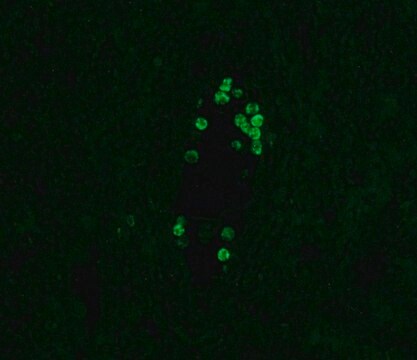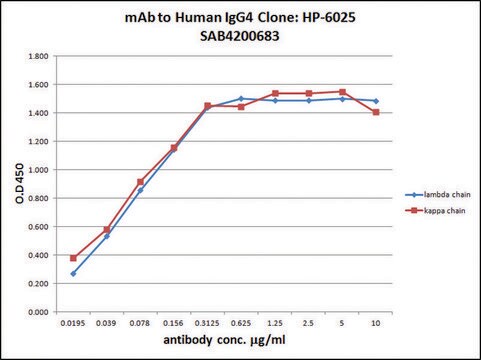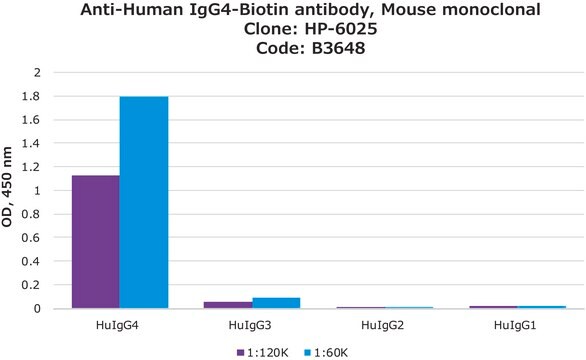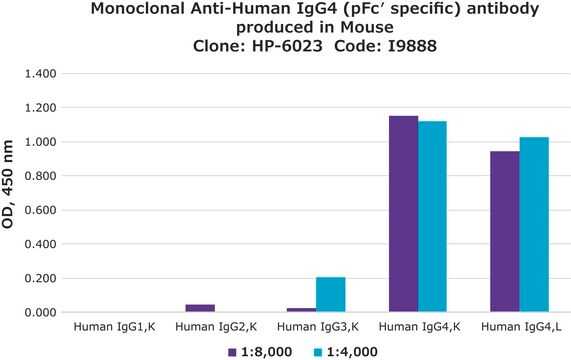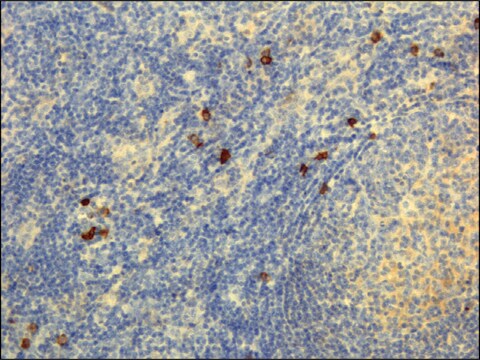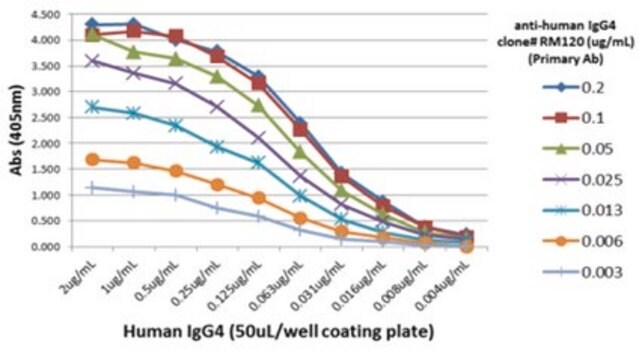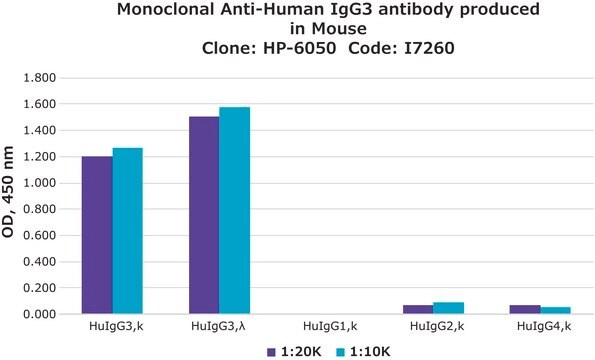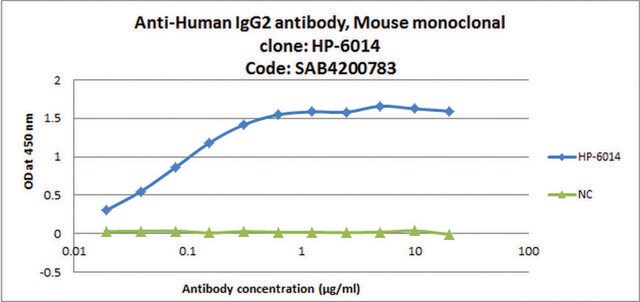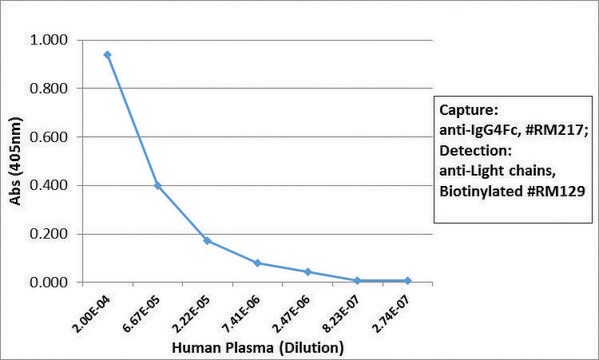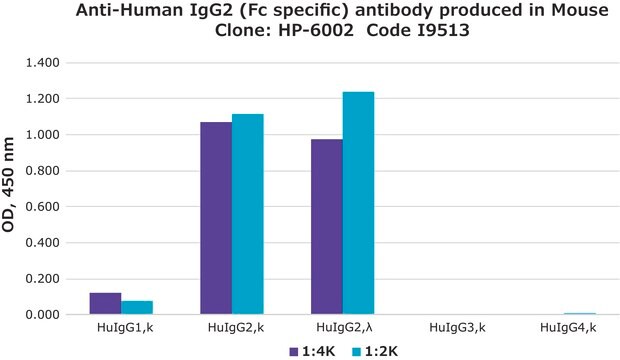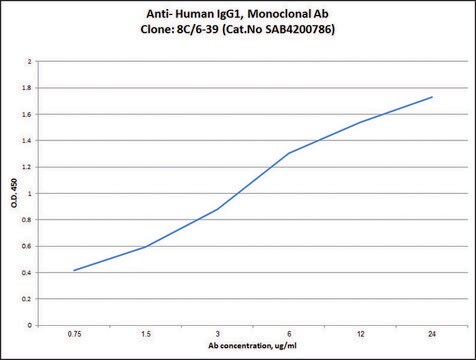I7385
Monoclonal Anti-Human IgG4 antibody produced in mouse
clone HP-6025, ascites fluid
Synonym(s):
Monoclonal Anti-Human IgG4
Sign Into View Organizational & Contract Pricing
All Photos(1)
About This Item
UNSPSC Code:
12352203
NACRES:
NA.46
Recommended Products
biological source
mouse
Quality Level
conjugate
unconjugated
antibody form
ascites fluid
antibody product type
secondary antibodies
clone
HP-6025, monoclonal
contains
15 mM sodium azide
technique(s)
immunofluorescence: suitable
indirect ELISA: 1:5,000
isotype
IgG1
shipped in
dry ice
storage temp.
−20°C
target post-translational modification
unmodified
Looking for similar products? Visit Product Comparison Guide
General description
IgG4 (Immunoglobulin G4) is produced by T helper 2 cytokines. Unlike other immunoglobulin G is rare and constitutes to only 3-4 percent of the total IgG in the serum.
Specificity
Monoclonal Anti-Human IgG4 is specific for the IgG4 subclass and nonreactive with IgG1, IgG2 and IgG3 in an ELISA.
Application
Monoclonal Anti-HuIgG4 man antibody produced in mouse has been used in ELISA and immunofluorescence.
The IUIS/WHO2 study singled out this monoclonal antibody as one of the most widely applicable IgG4 specific monoclonal antibodies. Monoclonal Anti-Human IgG4 may be used for the identification of the IgG4 subclass by various immunoassays including: ELISA, Imprint Immunofixation (IIF), Immunofluorometric Assay (IFMA), Hemagglutination (HA), Hemagglutination Inhibition (HAI), Particle Counting Immunoassay (PACIA), and detection of cytoplasmic IgG.
Biochem/physiol Actions
IgG4 (Immunoglobulin G4) antibody has reduced affinity for C1q (first component of complement q) and hence its anti-inflammatory activity differing from that of the other IgG subclasses. IgG4 antibodies are known to actively interchange Fab arms with another molecule, resulting in recombined antibodies with two different binding specificities. This exchange is considered as an important biological mechanism that contributes to its anti-inflammatory activity. IgG4 antibodies are normally noninflammatory, but autoreactive IgG4 antibodies are known to be associated with Immunoglobulin G4 (IgG4)-related disease (IgG4-RD), characterized by infiltrating lymphoplasmacytic cells and elevated serum IgG4. Increased levels of IgG4 is observed in atopic dermatitis, parasitic diseases, pemphigus vulgaris and pemphigus foliaceus.
Disclaimer
Unless otherwise stated in our catalog or other company documentation accompanying the product(s), our products are intended for research use only and are not to be used for any other purpose, which includes but is not limited to, unauthorized commercial uses, in vitro diagnostic uses, ex vivo or in vivo therapeutic uses or any type of consumption or application to humans or animals.
Not finding the right product?
Try our Product Selector Tool.
Storage Class Code
10 - Combustible liquids
WGK
nwg
Flash Point(F)
Not applicable
Flash Point(C)
Not applicable
Choose from one of the most recent versions:
Already Own This Product?
Find documentation for the products that you have recently purchased in the Document Library.
Customers Also Viewed
Francois Romagné et al.
Blood, 114(13), 2667-2677 (2009-06-26)
Inhibitory-cell killer immunoglobulin-like receptors (KIR) negatively regulate natural killer (NK) cell-mediated killing of HLA class I-expressing tumors. Lack of KIR-HLA class I interactions has been associated with potent NK-mediated antitumor efficacy and increased survival in acute myeloid leukemia (AML) patients
Preclinical characterization of 1-7F9, a novel human anti?KIR receptor therapeutic antibody that augments natural killer?mediated killing of tumor cells.
Romagne F, et al.
Blood, 114(13), 2667-2677 (2009)
High serum IgG4 concentrations in patients with sclerosing pancreatitis.
Hamano H, et al.
The New England Journal of Medicine, 344(10), 732-738 (2001)
Charge and size selectivity of proteinuria in children with idiopathic nephrotic syndrome.
Taylor G M, et al.
Pediatric Nephrology (Berlin), 11(4), 404-410 (1997)
L M Silva et al.
Hormone research, 59(3), 118-124 (2003-03-15)
To evaluate the immunoglobulin G subclasses of anti-TPO and antibody avidity in patients with subclinical hypothyroidism (sH), overt hypothyroidism (H) and a control group (C). According to the TSH, fT4 and anti-TPO antibody levels, appraised by immunometric assays, 95 female
Our team of scientists has experience in all areas of research including Life Science, Material Science, Chemical Synthesis, Chromatography, Analytical and many others.
Contact Technical Service